Introducing CrystalViewer
New Tools For Making Distance Learning Effective - and Fun

Runs Natively on
Apple Silicon
and Intel
CrystalViewer 11 is a brand-new application for exploring crystal & molecular structures. Based around a "photo-album" interface with gorgeous "Retina" graphics, CrystalViewer's comprehensive, curated structures library is a delight to explore. Users can visualize - and interact with - any of the included structures. With its real-time rotation, scaling, measurement - and breathtaking "out-of-the-screen" 3D stereo - CrystalViewer blows away dusty laboratory teaching and empowers students to understand our crystalline world.
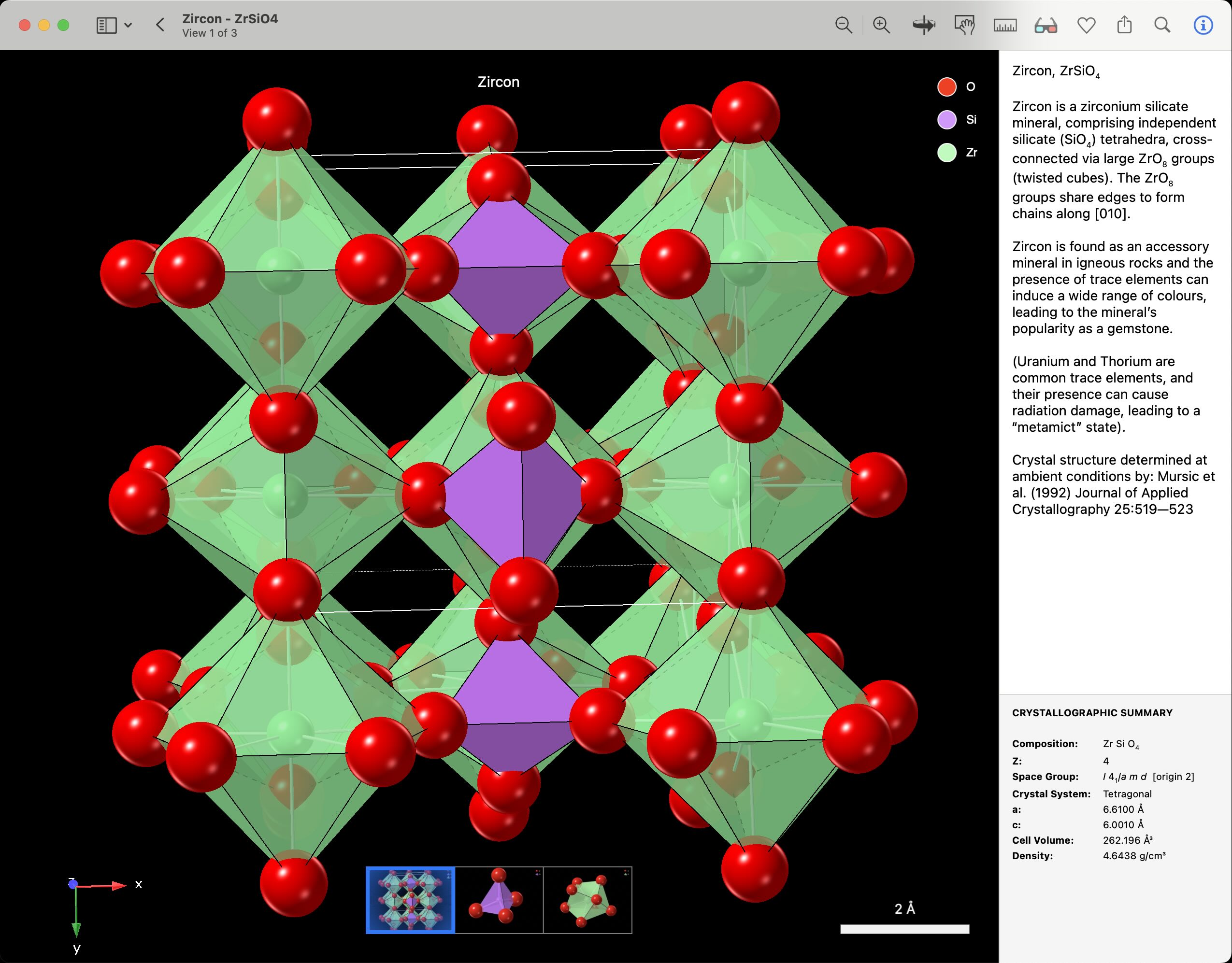
Even the most-complex structure can be understood in terms of basic building blocks. Here the crystal structure of zircon is shown as a stylized, polyhedral model, with individual building blocks accessed by clicking their thumbnails at the bottom of the window.
Reference Library
Our comprehensive Materials Library includes some 1400 structures (annotated, with references and metadata), grouped into three broad categories: Hybrid Materials, Inorganics and Organics. A dedicated Minerals Library contains some 600 minerals, including major rock-forming minerals, gemstones, ores, high-pressure phases and extraterrestrial minerals. (Also included in the Inorganics library.)
Not Just Another Database
We believe in making science open and accessible. We don't think you should have to wade through decades of dusty publications to find the right structure. Neither should you have to try your luck with dodgy data files downloaded from online archives. That's why we've provided a carefully-curated collection of our own: converting arcane data into precious 3D artworks. And for the most-effective - and elegant - presentation, we've combined these into a single, beautifully-designed application. Science as art; knowledge as power: indulge your passion.
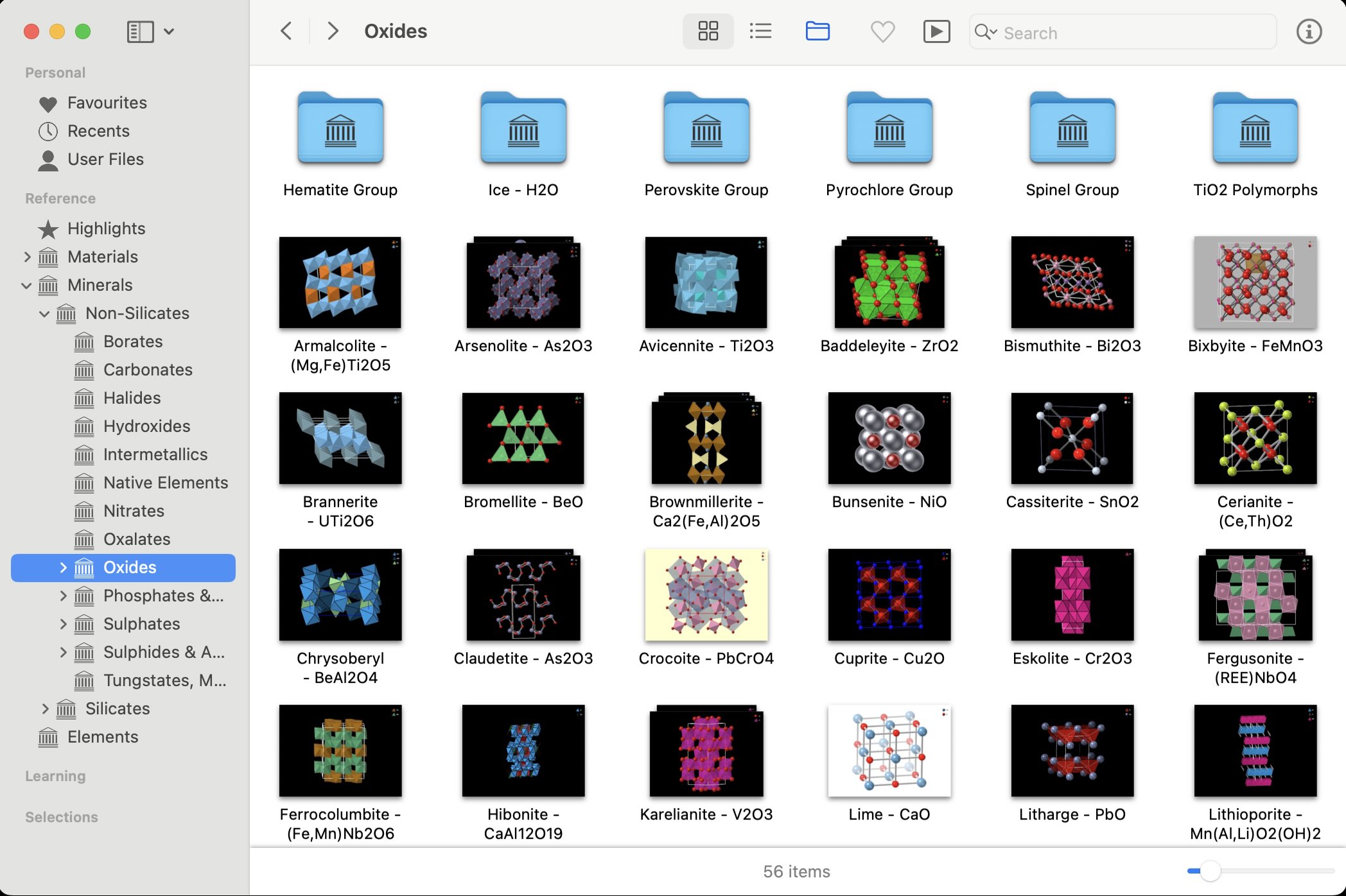
CrystalViewer's elegant browser interface (with animated thumbnails) lets you readily scan groups of structures. The sidebar on the left lets you navigate a folder structure, complemented by a "Go" menu and a Search command.
Powerful Search & Indexing
Take advantage of powerful search and flexible browsing to quickly find the structures you need. The Search command (available at all times in the browser) includes a "Smart" search mode which identifies chemical formulae - but can be extensively customized via a Scope bar. Search results are presented in the browser - here shown in its "List View".
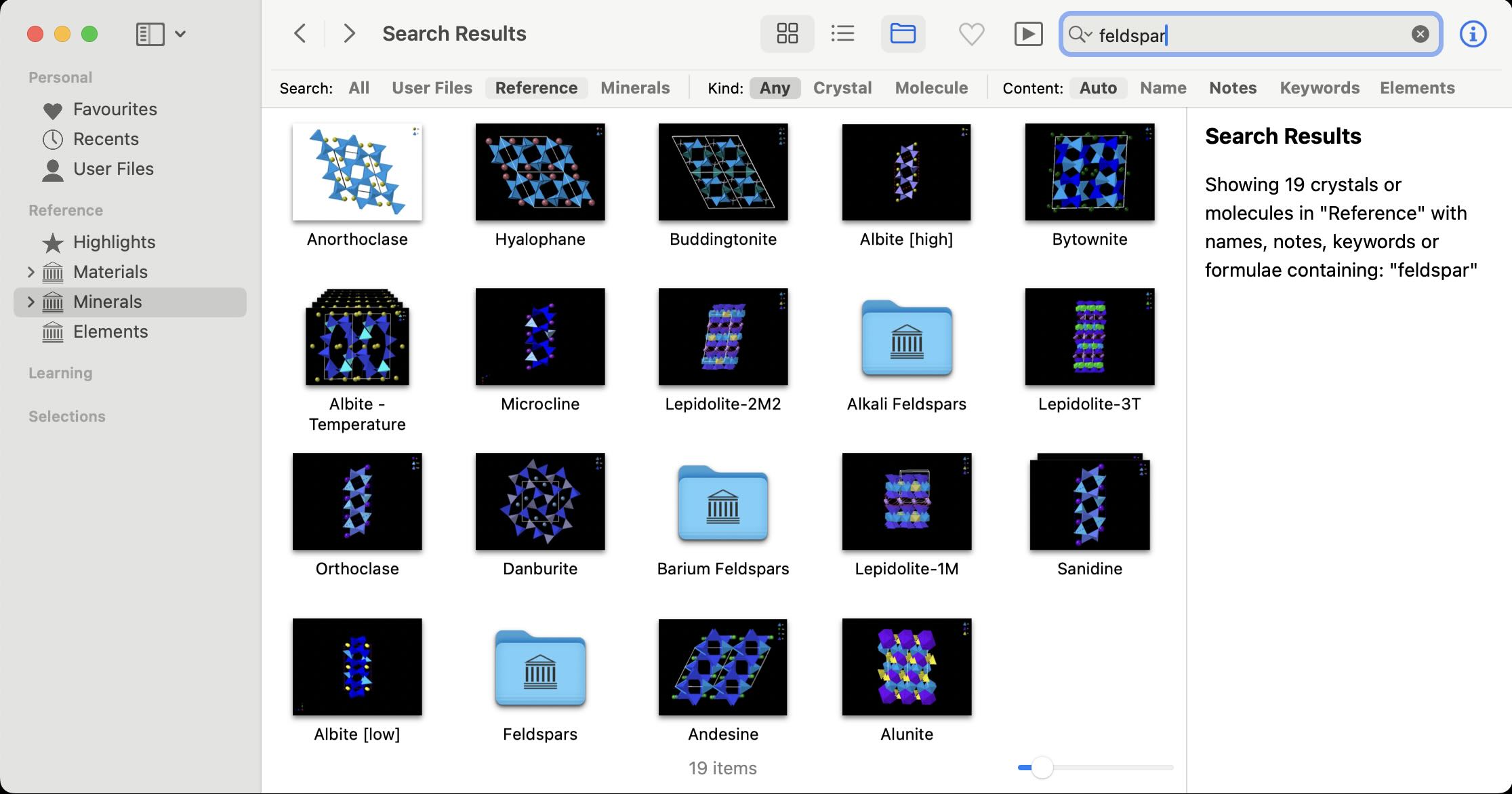
Using the Smart Search command to find Feldspar (or Feldspar-related) minerals.
CrystalViewer's sidebar provides a comprehensive hierarchical guide to the reference and teaching libraries, but you can opt to show an index of structure names, an index of minerals or even an index of chemical formulae (with automatic grouping of isomers/polymorphs).
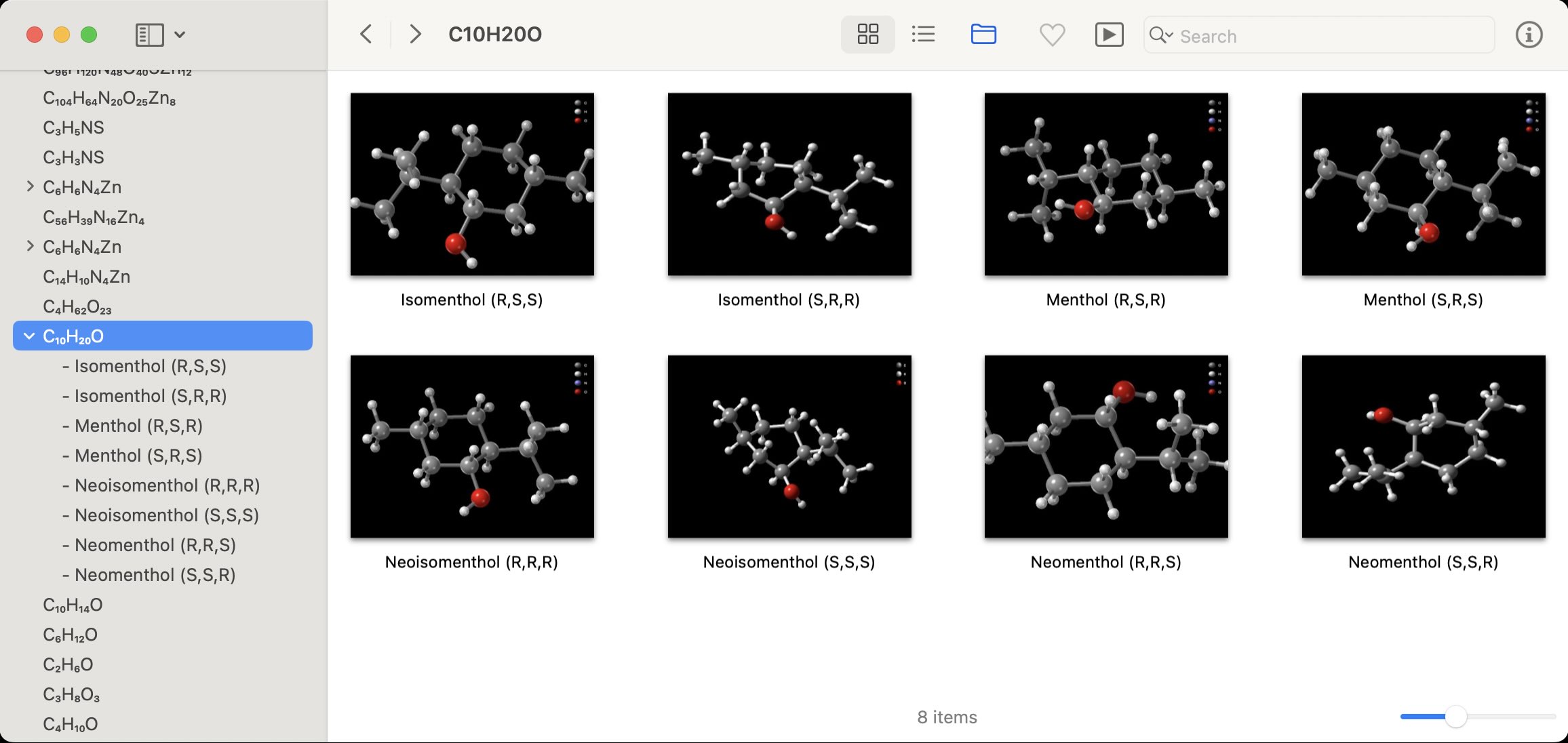
Browsing the index of chemical formulae.
Measurement
CrystalViewer's "Measurement Mode" provides interactive identification and measurement - with haptic feedback (Mac). Identify atoms, polyhedra and bond distances by rolling over them with the mouse. Shift-click groups of two or three atoms to measure their interatomic distances and angles.
When using the Viewer, the optional Info Inspector shows a summary of crystallographic information, including crystal system, space group, cell parameters, chemical formula and density (some of which can also be seen, in tabular form, using the browser's "List View").
Spectacular 3D - in Colour!
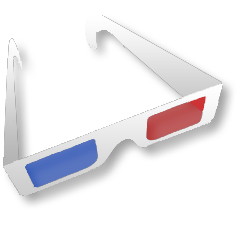
Click on the Red/Blue stereo icon in the Viewer toolbar to show any structure in breathtaking "out-of-the-screen" 3D - and in colour! This works with any colour screen and a pair of (low cost) red-blue stereo spectacles (readily obtained online). CrystalViewer lets you customize the perceived "depth" of the image - whether floating on your desktop in front of the screen, or appearing "behind" the screen; as well as choosing colour or greyscale viewing modes. (When using 3D Stereo in Colour, CrystalViewer optimizes your structure's colours so that they are compatible with the red/cyan filtering used.)
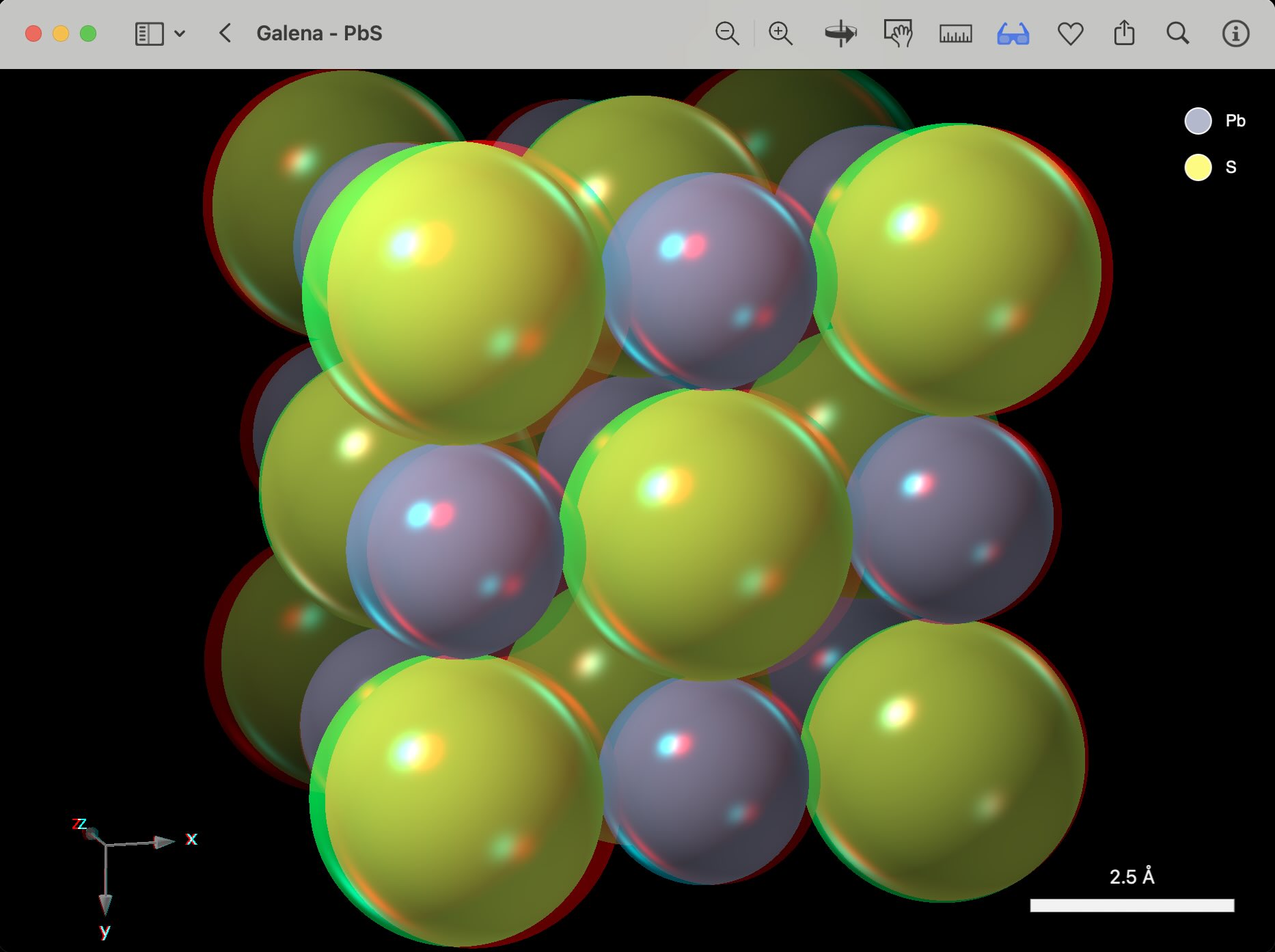
Red-Blue stereo image showing a space-filling model of Galena (PbS).
Animation
Many files contain more than one structural model: offering you the chance to explore their structural architecture in terms of basic building blocks, or structural proxies. These microscopic "Lego bricks" help you "see the wood for the trees", understanding the full structure in terms of a series of building bricks, rather than thousands of individual atoms and chemical bonds.
We also explore structural behaviour and phase transitions, with a range of self-running animations: for example, the same structure at different temperatures or pressures. You can even rotate the animating structures, to see changes from different directions - or with different model types.
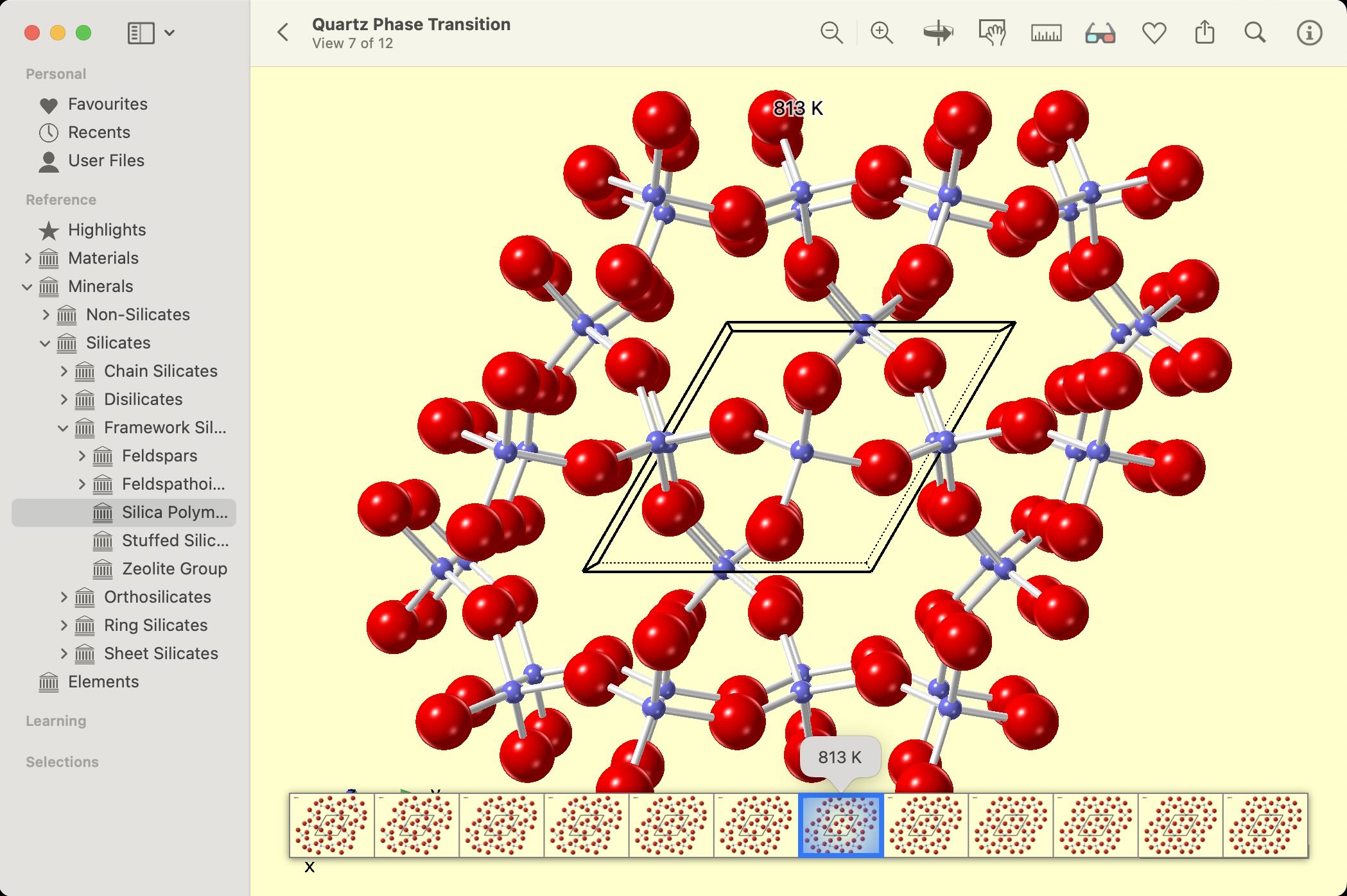
Multi-structure documents let you animate structural behaviour and phase transitions, as shown here for the alpha/beta phase transition on heating Quartz.
Deeper Learning
CrystalViewer is designed to help students of all ages learn more about the microscopic world. Our teaching libraries are designed to build a fundamental understanding of crystallography, including: atomic radii; lattice types; lattice defects; polyhedral representations; basic concepts of close-packing, interstices and silicate polymerization; and a general awareness of basic "type structures".
Learning Collections
Atomic Radii: Periodic Tables of the Elements showing atomic, ionic, covalent and van-der-Waals radii.
Lattice Types: Rotatable models of each of the 14 Bravais Lattices, plus Hexagonal/Rhombohedral comparison model.
Lattice Defects: 3D models showing twins, polysynthetic twinning, edge & screw dislocations; dislocation loop; Frenkel, Schottky defects; stacking fault.
Polyhedra: Coordination polyhedra found in typical crystals.
Building Crystals: Self-guided tutorials introducing fundamentals of crystal chemistry. Each multi-structure document provides a unique tour of a key structure, building on concepts such as close-packing, interstices, polymerization and the use of structural motifs to represent coordination units or molecular groups and simplify visualization.
Close Packing: Introduction to Close Packing; Hexagonal Close Packing; Cubic Close Packing.
Filling Interstices: Introduction to Interstices; Structures based on filling tetrahedral or octahedral interstices in hexagonal- or cubic-close-packed materials. Includes: Wurtzite; Sphalerite; Halite; Olivine; Spinel; Hematite.
Silicates: Introduction to Silicate Polymerization; Sequence of key silicate minerals illustrating the sequence from isolated tetrahedra (orthosilicates), through to infinite chains, sheets and fully-polymerized frameworks. Includes: Garnet; Pyroxene; Amphibole; Mica; Kaolinite; Feldspar; Quartz; Zeolite ZK5.
Non Silicates: Calcite.
New Materials: More complex structures introduced in terms of their fundamental building blocks. Includes YBCO (Superconductor); ZIF8 (potential gas-storage phase).
Crystal Chemistry: Crystallographic "Type Structures", organised by anion/cation ratios, e.g., "AB, AB2, AB2X4, etc.". Includes animated teaching models of cubic close packing, hexagonal close packing, diamond and graphite, etc.
Quiz: Learn crystallography with these exercises on Lattice Types, Miller Indices and Basic Structure Types.
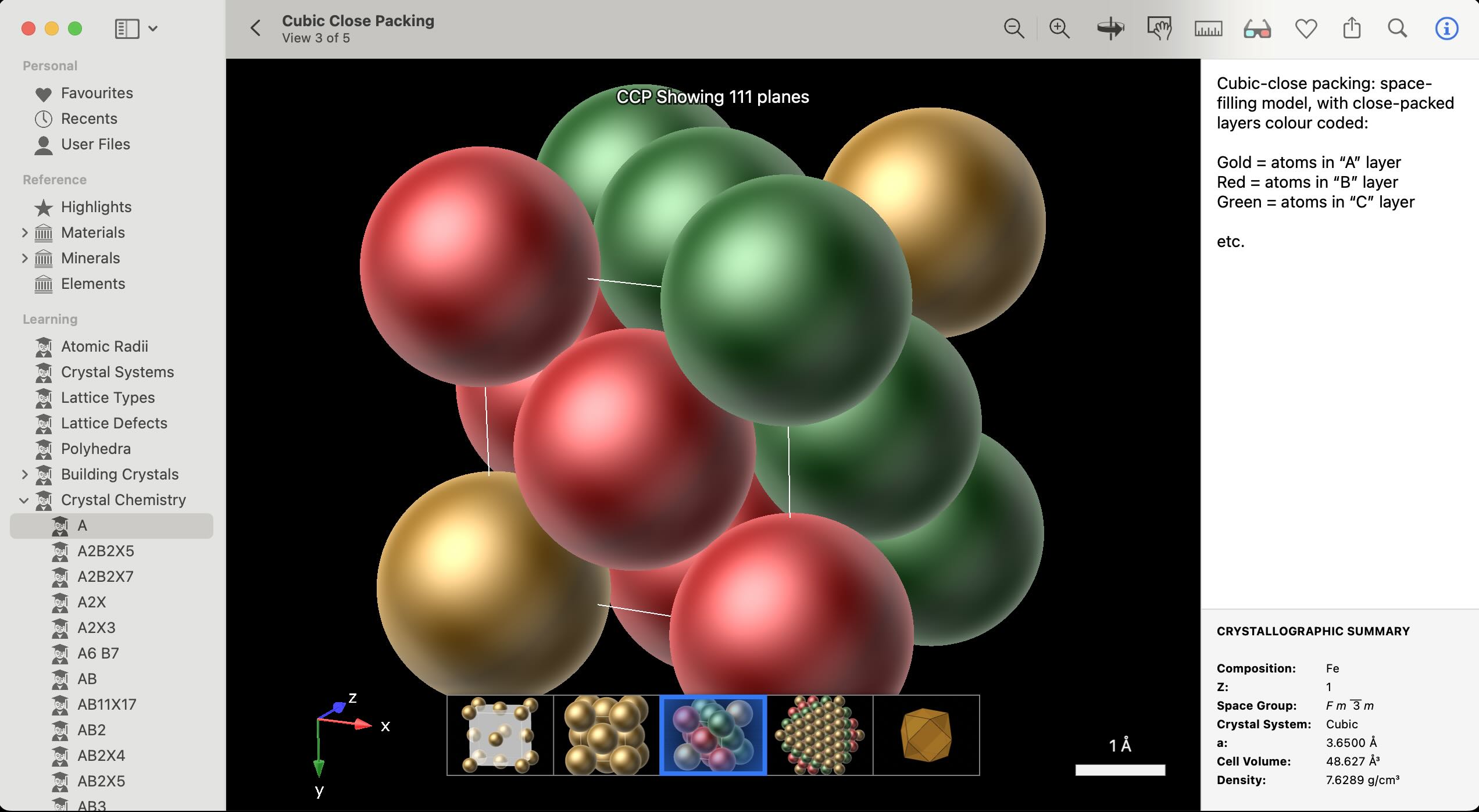
The Crystal Chemistry library provides a wealth of teaching resources for understanding fundamental "type" structures, such as close packed metals.
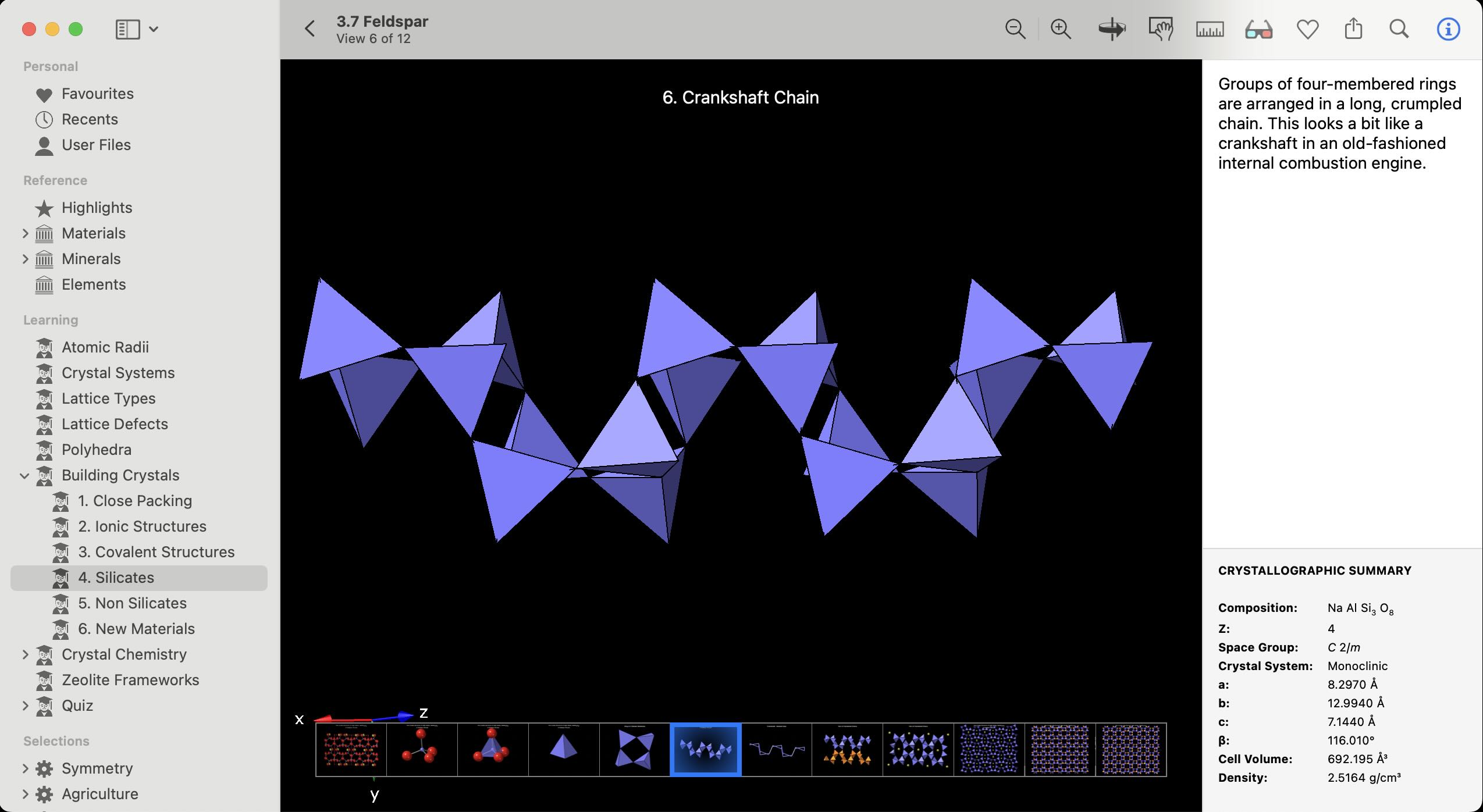
Building Crystals provides a self-guided tour to important structures in terms of their fundamental building bricks and how these are arranged.
Thematic Selections
Whilst you are free to browse the reference collection, search for specifics or use the various indexes, you can also take advantage of our liberal use of cross referencing. In fact, we've provided a wide range of structural "selections", which link to the main reference library, but are grouped thematically.
Current themes include Health & Environment (Agriculture, Food, Medicines, Narcotics); High-Tech (Battery Materials, Hydrogen Storage, Semiconductors), Geology (Extraterrestrial, Gemstones, High-Pressure Crystals, Magnetic Materials, Ores), plus general-interest topics including Asbestos, Chemical Weapons, Explosives, Pigments, Radioactivity. There's something in there for everyone!

Cross-referencing the reference library, our Selections include a wide variety of topical themes as well as general interest areas such as the colour pigments shown here.
Customizable
Make CrystalViewer your own by marking favourite files, keeping track of recently-opened files - and changing the program's behaviour via the Preferences Panel.
CrystalViewer also lets you add your own structures by dragging-and-dropping documents and folders into the User Files collection. Add new folders, rearrange content, rename entries.
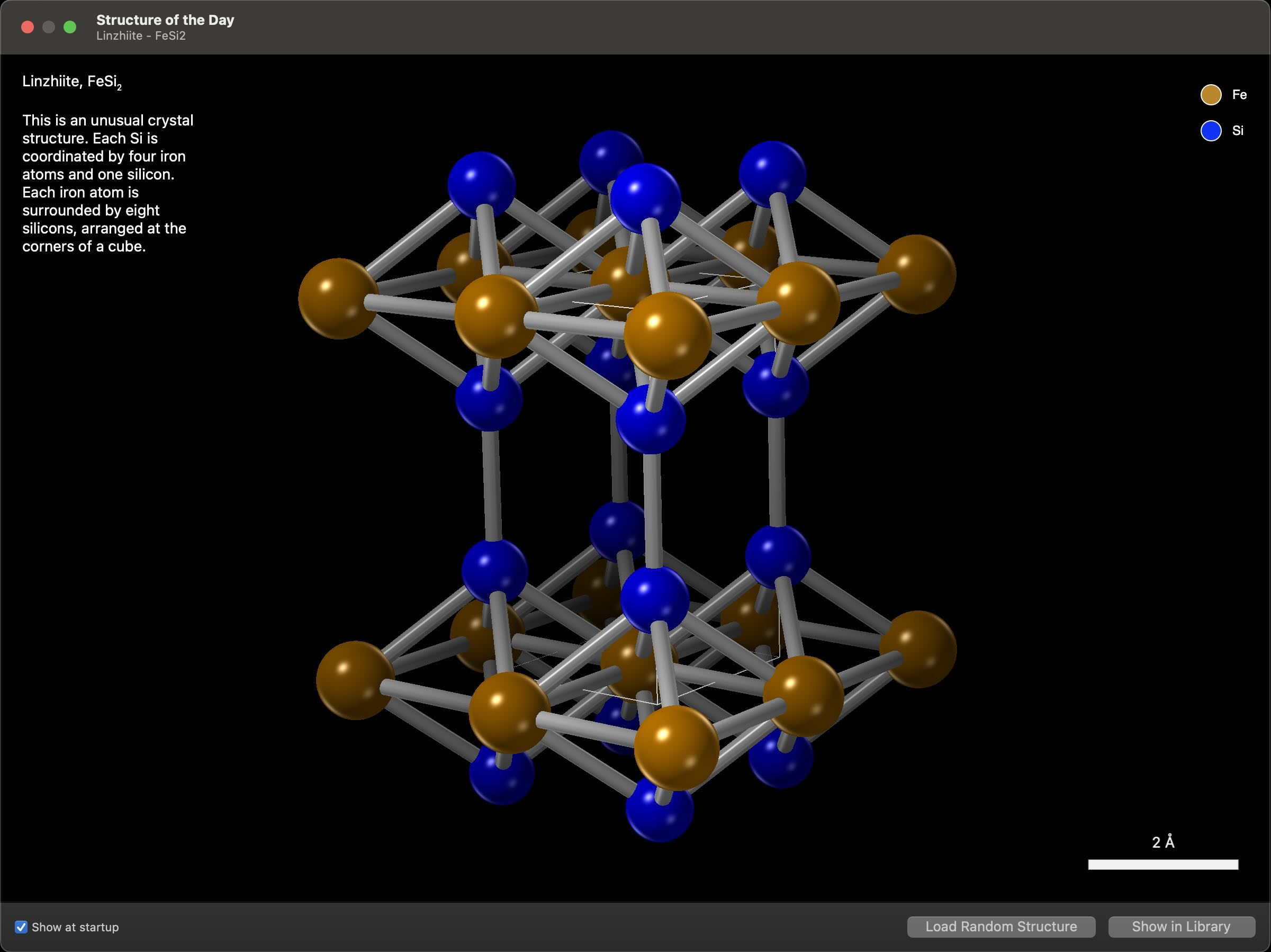
You can opt to browse random structures, including the option of a random "Structure of the Day" at startup.
Cross Platform - Done Properly

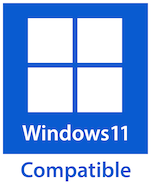
CrystalViewer is available in two separate versions, for 64-bit Windows, or 64-bit macOS. Mac and Windows versions share the same binary document format, and similar feature sets, making cross-platform working and collaboration easy. Each version is designed, from the ground up, for its respective operating system, offering genuine operating system support and maximum performance - with no compromises.
Try it out for yourself: Download CrystalViewer for Mac or Windows today. Plus, learn how our low-cost, flexible site licensing helps empower your research and enthuse your students.
CrystalViewer vs CrystalMaker? The standalone CrystalViewer 11 application is designed to provide a simpler way of understanding pre-existing structure models, without the complexity of a powerful crystal/molecular modelling program - and is ideal for introductory teaching classes in mineralogy and solid-state chemistry. But you can also "have your cake and eat it", as CrystalViewer is included in the new CrystalMaker 11 licence. That's right, the world's best materials modelling software now includes full access to CrystalViewer, so you can take advantage of the curated structures libraries and add your own models.